Indesit DFG-15B1-A User Manual [en, ru, de, fr]

Operating instructions
DISHWASHER
|
|
|
|
|
|
|
|
|
|
|
|
|
Contents |
|
EN |
|
FR |
|
DE |
|
|
|
|
|
|||
|
|
|
|
|
|
Product Fiche, 2 |
|
|
|
|
|
|
English,1 Français, 14 Deutsch, 28
NL |
|
RU |
|
UA |
|
|
|
|
|
|
|
Nederlands, 41 |
Русский, 54 |
Українська, 68 |
|||
Precautions and advice, 3
General safety Disposal
Saving energy and respecting the environment
Installation and Assistance, 4-5
Positioning and levelling
Connecting the water and electricity supplies Advice regarding the first wash cycle Technical data
Assistance
DFG 15B1
Description of the appliance, 6
Overall view Control panel
Loading the racks, 7-8
Lower rack
Cutlery basket
Upper rack
Adjusting the upper rack
Start-up and use, 9
Starting the dishwasher
Measuring out the detergent
Wash cycles, 10
Table of wash cycles
Rinse aid and refined salt, 11
Measuring out the rinse aid Measuring out the refined salt
Care and maintenance, 12
Shutting off the water and electricity supplies Cleaning the dishwasher
Preventing unpleasant odours Cleaning the sprayer arms Cleaning the water inlet filter Cleaning the filters
Leaving the machine unused for extended periods
Troubleshooting, 13

Product fiche
|
|
|
|
|
|
|
|
|
|
EN |
|
Product Fiche |
|
|
|
|
Brand |
|
INDESIT |
|
|
|
||
|
|
|
|
|
|
|
Model |
|
DFG 15B1 |
|
|
|
|
|
|
|
Rated capacity in standard place settings (1) |
|
13 |
|
|
|
|
|
|
|
Energy efficiency class on a scale from A+++ (low consumption) to D |
(high consumption) |
A+ |
|
|
|
|
|
|
|
Energy consumption per year in kWh (2) |
|
295.0 |
|
|
|
|
|
|
|
Energy consumption of the standard cleaning cycle in kWh |
|
1.04 |
|
|
|
|
|
|
|
Power consumption of the off-mode in W |
|
0.5 |
|
|
|
|
|
|
|
Power consumption of the left-on mode in W |
|
5.0 |
|
|
|
|
|
|
|
Water consumption per year in litres (3) |
|
3080.0 |
|
|
|
|
|
|
|
Drying efficacy class on a scale from G (low efficacy) to A (high efficacy) |
A |
|
|
|
|
|
|
|
|
Programme time for standard cleaning cycle in minutes |
|
190 |
|
|
|
|
|
|
|
The duration of the left-on mode in minutes |
|
10 |
|
|
|
|
|
|
|
Noise in dB(A) Re 1pW |
|
49 |
|
|
|
|
|
|
|
Built-in model |
|
No |
|
|
|
|
|
|
|
|
|
|
|
|
NOTES |
|
|
|
|
1) The information on the label and fiche relates to the standard cleaning cycle, this programme is suitable to clean normally |
||
|
|
soiled tableware and it is the most efficient programme in terms of combined energy and water consumption. The standard |
||
|
|
cleaning cycle corresponds to the Eco cycle. |
|
|
|
|
|
||
|
|
2) Based on 280 standard cleaning cycles using cold water fill and the consumption of the low power modes. Actual energy |
||
|
|
consumption depends on how the appliance is used. |
|
|
|
|
|
|
|
|
|
3) Based on 280 standard cleaning cycles. Actual water consumption |
depends on how the appliance is used. |
|
|
|
|
|
|
2

Precautions and advice
 This appliance was designed and manufactured in compliance with international safety standards The following information has been provided for safety reasons and should therefore be read
This appliance was designed and manufactured in compliance with international safety standards The following information has been provided for safety reasons and should therefore be read
carefully.
Keep this instruction manual in a safe place for future reference. If the appliance is sold, given away or moved, please ensure the manual is kept with the
machine.
Please read these instructions carefully: they contain important information on installation, use and safety.
This appliance is designed for domestic use or similar applications, for example:
-staff kitchen areas in shops, offices and other work environments;
-farmhouses;
-use by guests in hotels, motels and other residential settings;
-bed & breakfasts.
General safety
•The appliance should not be operated by people
(including children) with reduced physical, sensory or mental capacities, or by inexperienced people who are not familiar with the product, unless supervision or instructions on how to use it are provided by someone who assumes responsibility for their safety.
•An adult must supervise children at all times to prevent them from playing with the appliance.
•The appliance was designed for domestic use inside the home and is not intended for commercial or industrial use.
•The appliance must be used by adults only to wash domestic crockery in accordance with the instructions in this manual.
•The appliance must not be installed outdoors, even in covered areas. It is extremely dangerous to leave the machine exposed to rain and storms.
•Do not touch the appliance when barefoot.
•When unplugging the appliance always pull the plug from the mains socket. Do not pull on the cable.
•The water supply tap must be shut off and the plug should be removed from the electrical socket before cleaning or maintaining the appliance.
•If the appliance breaks down, do not under any circumstances touch the internal parts in an attempt to perform the repair work yourself.
•Do not lean or sit on the open door of the appliance: this may cause the appliance to overturn.
•The door should not be left open as it may create a dangerous obstacle.
•Keep detergent and rinse aid out of reach of children.
•The packaging material should not be used as a toy for children.
Disposal |
|
|
EN |
||
• Disposal of packaging material: observe local |
||
|
||
legislation so that the packaging may be reused. |
|
|
|
||
• The European Directive 2012/19/EU relating |
|
|
to Waste Electrical and Electronic Equipment |
|
|
(WEEE) states that household appliances should |
|
|
not be disposed of using the normal solid urban |
|
|
waste cycle. Exhausted appliances should be |
|
|
collected separately in order to optimise the re- |
|
|
using and recycling rate of the materials inside the |
|
|
machine, while preventing potential damage to |
|
|
the environment and public health. The crossed- |
|
|
out dustbin symbol is marked on all products to |
|
|
remind the owners of their obligations regarding |
|
|
separated waste collection. |
|
|
For further information relating to the correct |
|
|
disposal of household appliances, owners may |
|
|
contact the relevant public authority or the local |
|
|
appliance dealer. |
|
|
Saving energy and respecting the |
|
|
environment |
|
Saving water and energy
•Only begin a wash cycle when the dishwasher is full. While waiting for the dishwasher to be filled, prevent unpleasant odours using the Soak cycle
(see Wash cycles).
•Select a wash cycle that is suited to the type of crockery and to the soil level of the crockery using the Table of wash cycles:
-for dishes with a normal soil level use the Eco wash cycle, which ensures low energy/water consumption levels.
-If the load is smaller than usual activate the Half
Load option* (see Start-up and use).
•If your electricity supply contract gives details of electricity-saving time bands, run wash cycles when electricity prices are lower. The Delayed
Start button * (see Start-up and use) helps you organise the wash cycles accordingly.
Phosphate-free and chlorine-free detergents containing enzymes
•We strongly recommend that you use detergents that do not contain phosphates or chlorine, as these products are harmful to the environment.
•Enzymes provide a particularly effective action at temperatures around 50°C. As a result detergents containing enzymes can be used in conjunction with low-temperature wash cycles in order to achieve the same results as a normal 65°C wash cycle.
•To avoid wasting detergent, use the product in appropriatequantitiesbasedonthemanufacturer’s recommendations, the hardness of the water, the soil level and the quantity of crockery to be washed. Even if they are biodegradable, detergents contain substances which may alter the balance of nature.
*Only available in selected models.
3
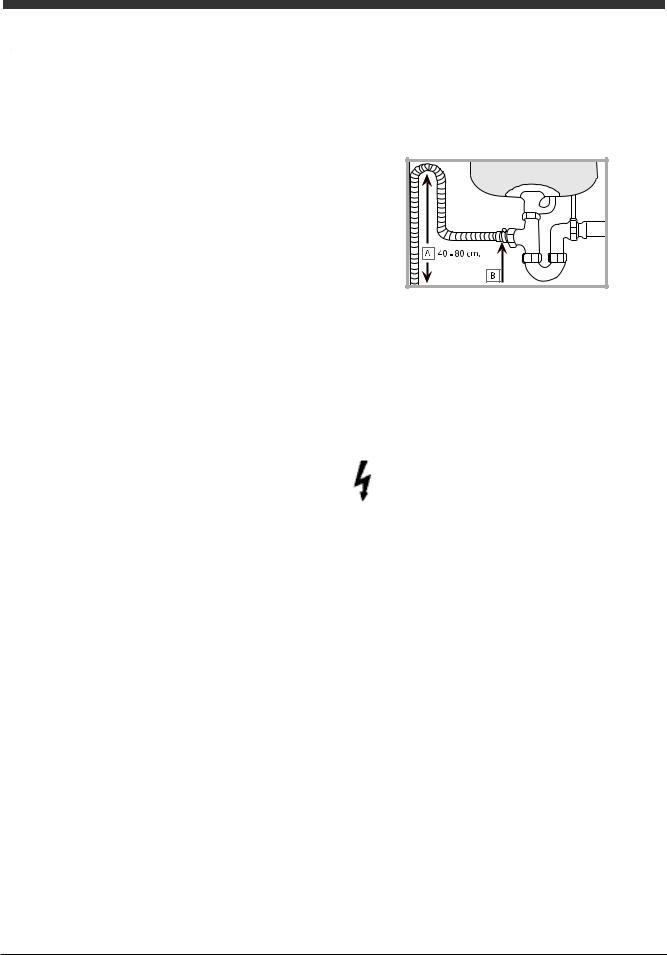
Installation and Assistance
EN |
|
|
If the appliance must be moved at any time, keep it in an |
|
|
|
|||
upright position; if absolutely necessary, it may be tilted onto its |
||||
|
||||
|
back. |
|||
Positioning and levelling
1.Remove the appliance from all packaging and check that it has not been damaged during transportation. If it has been damaged, contact the retailer and do not proceed any further with the installation process.
2.Arrange the dishwasher so that its sides or back panel are in contact with the adjacent cabinets or the wall. This appliance
can also be recessed under a single worktop* (see the Assembly Instruction sheet.)
3. Position the dishwasher on a level sturdy floor. If the floor is uneven, the front feet of the appliance should be adjusted until it reaches a horizontal position. If the appliance is levelled correctly, it will be more stable and much less likely to move or cause vibrations and noise while it is operating.
4*. To adjust the height of the rear foot, turn the red hexagonal bushing on the lower central part at the front of the dishwasher using a hexagonal spanner with an opening of 8 mm. Turn the spanner in a clockwise direction to increase the height and in an anticlockwise direction to decrease it (see Building-in Instruction sheet attached to the documentation.)
Connecting the water and electricity supplies
 Connection to the water and electricity supplies should only be performed by a qualified technician.
Connection to the water and electricity supplies should only be performed by a qualified technician.
 The dishwasher should not stand on the water hoses or electricity supply cable.
The dishwasher should not stand on the water hoses or electricity supply cable.
 The appliance must be connected to the water supply network using new hoses.
The appliance must be connected to the water supply network using new hoses.
Never use old or second hand hose sets. Do not reuse hose sets from any previously installed dishwasher.
The water inlet and outlet hoses and the electricity supply cable may be positioned towards the right or the left in order to achieve the best possible installation.
Connecting the water inlet hose
•To a suitable cold water connection point: before attaching the hose, run the water until it is perfectly clear so that any impurities that may be present in the water do not clog the appliance; after performing this operation, screw the inlet hose tightly onto a tap with a ¾ gas threaded connection.
•To a suitable hot water connection point: your dishwasher may be supplied with hot water from the mains supply (if you
have a central heating system with radiators) provided that it does not exceed a temperature of 60°C.
 Screw the hose to the tap as described for connection to a cold water supply.
Screw the hose to the tap as described for connection to a cold water supply.
 If the inlet hose is not long enough, contact a specialist store or an authorised technician (see Assistance.)
If the inlet hose is not long enough, contact a specialist store or an authorised technician (see Assistance.)
 The water pressure must be within the values indicated in the Technical Data table (see adjacent information.)
The water pressure must be within the values indicated in the Technical Data table (see adjacent information.)
The hose should not be bent or compressed.
Connecting the water outlet hose
Connect the outlet hose (without bending it) to a drain duct with a minimum diameter of 4 cm.
The outlet hose must be at a height ranging from 40 to 80 cm from the floor / surface where the dishwasher rests (A).
Before connecting the water outlet hose to the sink drain, remove the plastic plug (B).
Anti-flooding protection
To ensure floods do not occur, the dishwasher:
- is provided with a special system which blocks the water supply in the event of anomalies or leaks from inside the appliance.
Some models are also equipped with the supplementary safety device New Acqua Stop*, which guarantees anti-flooding protection even in the event of a supply hose rupture.
WARNING: HAZARDOUS VOLTAGE!
Under no circumstances should the water inlet hose be cut, as it contains live electrical parts.
Electrical connection
Before inserting the plug into the electrical socket, make sure that:
•The socket is earthed and complies with current regulations.
•the socket can withstand the maximum load of the appliance, which is indicated on the data plate located on the inside of the door
(see Description of the appliance);
•The power supply voltage falls within the values indicated on the data plate on the inside of the door.
•The socket is compatible with the plug of the appliance. If this is not the case, ask an authorised technician to replace the plug (see Assistance); do not use extension cables or multiple sockets.
 Once the appliance has been installed, the power supply cable and the electrical socket should be easily accessible.
Once the appliance has been installed, the power supply cable and the electrical socket should be easily accessible.
 The cable should not be bent or compressed.
The cable should not be bent or compressed.
 If the power supply cable is damaged, it must be replaced by the manufacturer or its Technical Assistance Service in order to prevent all potential hazards (see Assistance.)
If the power supply cable is damaged, it must be replaced by the manufacturer or its Technical Assistance Service in order to prevent all potential hazards (see Assistance.)
* Only available in selected models.
4
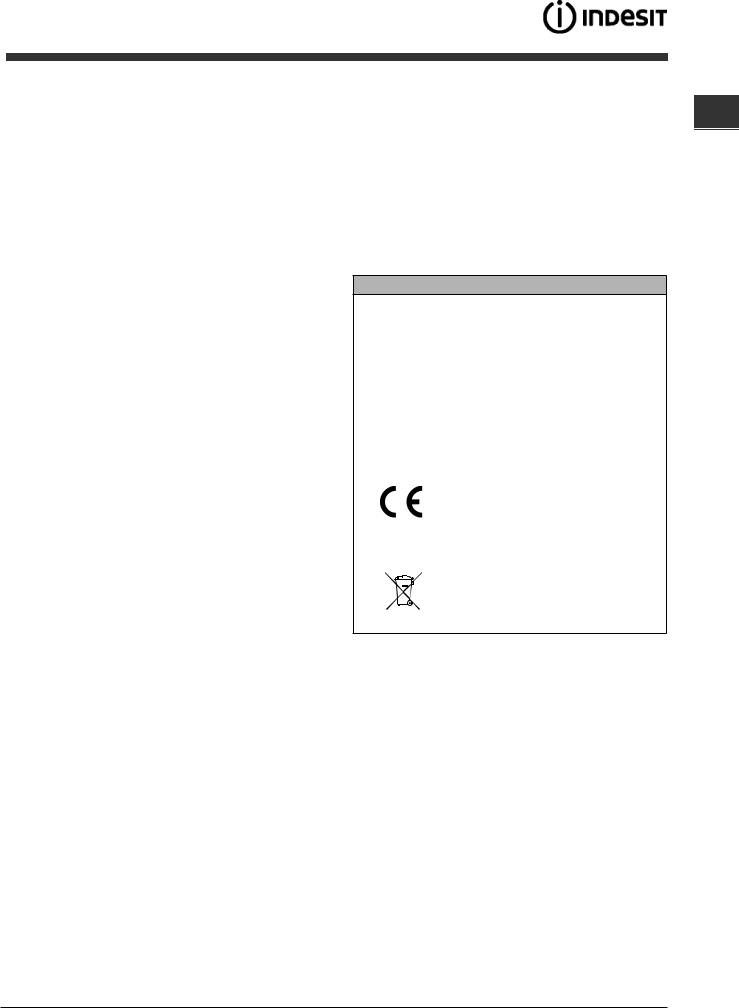
Anti-condensation strip*
After installing the dishwasher, open the door and stick the adhesive transparent strip under the wooden shelf in order to protect it from any condensation which may form.
Advice regarding the first wash cycle
After the installation, remove the stoppers from the racks and the retaining elastic elements from the upper rack, if any. Immediately before the fist washing, completely fill the salt dispenser with water and add only then approximately 1 kg of salt (see chapter entitled Rinse aid and refined salt). The water may overflow: this is normal and is not a cause for concern. Select the water hardness value (see chapter entitled Rinse aid and refined salt). - After the salt has been poured into the machine, the LOW SALT indicator light* switches off.
 If the salt container is not filled, the water softener and the heating element may be damaged as a result.
If the salt container is not filled, the water softener and the heating element may be damaged as a result.
Assistance
Before contacting Assistance:
•Check whether the problem can be resolved using the
Troubleshooting guide (see Troubleshooting).
•Restart the programme to check whether the problem has ceased to exist.
•If the problem persists, contact the Authorised
Technical Assistance Service.
 Never use the services of unauthorised technicians.
Never use the services of unauthorised technicians.
Please have the following information to hand:
•The type of malfunction.
•The appliance model (Mod.).
•The serial number (S/N).
This information can be found on the appliance data plate
(see Description of the appliance).
The machine has a buzzer/set of tones (depending on the dishwasher model) to inform the user that a command has EN been implemented: power on, cycle end etc. *
The symbols/indicator lights/LEDs on the control panel/ display may vary in colour and may have a flashing or fixed light (depending on the dishwasher model).
The display provides useful information concerning the type of wash cycle, drying/wash-cycle phase, remaining time, temperature etc etc.
Technical data
Dimensions |
width 60 cm |
||
height 85 cm |
|||
|
|
|
depth 60 cm |
Capacity |
13 standard place-settings |
||
|
|
|
|
Water supply pressure |
0,05 ÷ 1MPa (0.5 ÷ 10 bar) |
||
7,25 – 145 psi |
|||
Power supply voltage |
See appliance data plate |
||
|
|
||
Total absorbed power |
See appliance data plate |
||
|
|
||
Fuse |
See appliance data plate |
||
|
|
|
|
|
|
|
This dishwasher conforms to the |
|
|
|
following European Community |
|
|
|
Directives: |
|
|
|
-2006/95/EC (Low Voltage) |
|
|
|
-2004/108/EC (Electromagnetic |
|
|
|
Compatibility) |
|
|
|
-2009/125/EC (Comm. Reg. |
|
|
|
1016/2010) (Ecodesign) |
|
|
|
-97/17/EC (Labelling) |
|
|
|
-2012/19/EU Waste Electrical |
|
|
|
and Electronic Equipment |
|
|
|
(WEEE) |
|
|
|
|
* Only available in selected models.
5
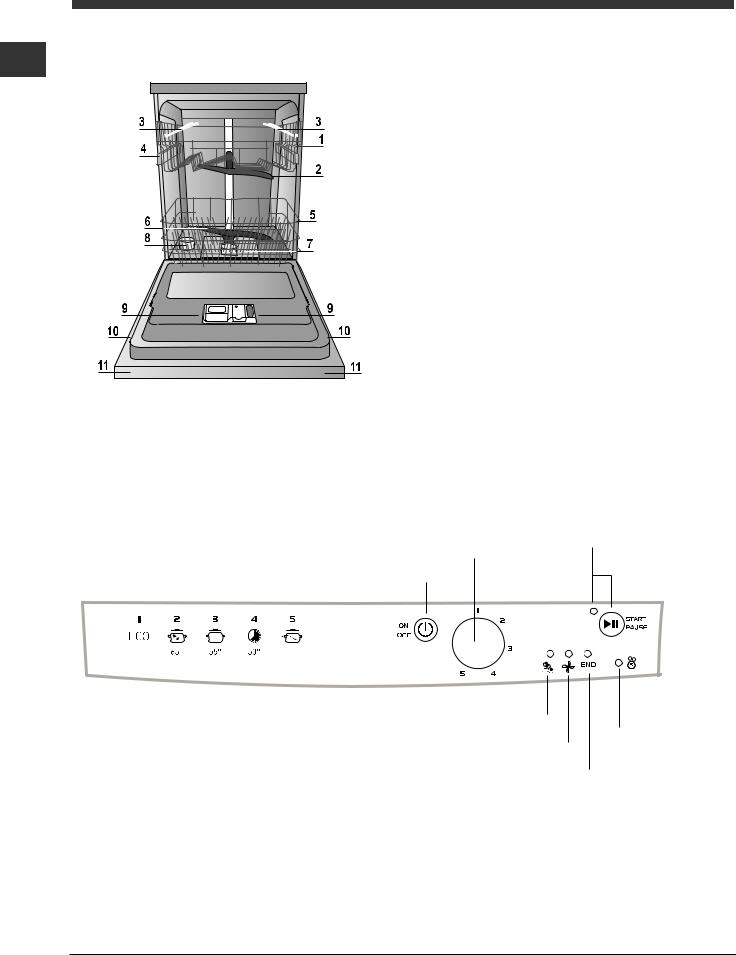
Description of the appliance
EN |
Overall view |
|
1. Upper rack
2. Upper sprayer arm
3. Tip-up dispensers
4. Rack height adjuster
5. Lower rack
6. Lower sprayer arm
7. Washing filter
8. Salt dispenser
9. Detergent dispenser, rinse-aid dispenser and Active Oxygen device*
10. Data plate
11. Control panel***
Control panel
Start/Pause button and
Cycle select knob indicator light
ON/OFF/Reset button
Indicator light Washing
Indicator light Low Salt
Indicator light Drying
Indicator light Wash Cycle End
***Only in completely built-in models. * Only available in selected models.
The number and type of wash cycles and options may vary depending on the dishwasher model.
6
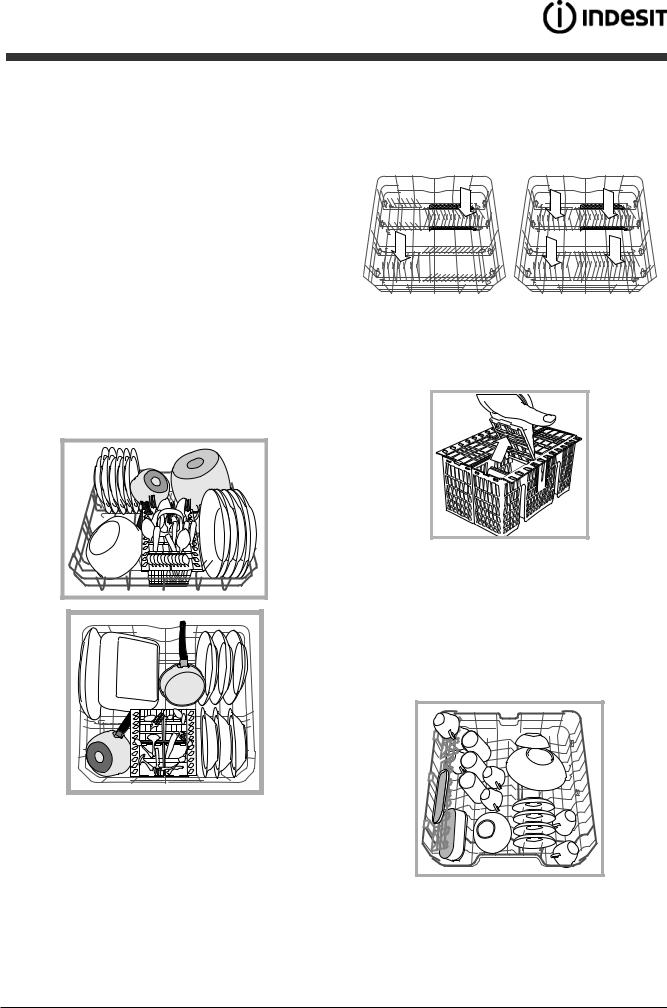
Loading the racks
Tips
Before loading the racks, remove all food residues from the crockery and empty liquids from glasses and containers. No preventive rinsing is needed under running water.
Arrange the crockery so that it is held in place firmly and does not tip over; and arrange the containers with the openings facing downwards and the concave/convex parts placed obliquely, thus allowing the water to reach every surface and flow freely. Make sure that the lids, handles, trays and frying pans do not prevent the sprayer arms from rotating. Place any small items in the cutlery basket.
Since plastic dishes and non-stick frying pans usually retain more water drops, their drying will be not so good as that of ceramic or stainless-steel dishes.
Lightweight items such as plastic containers should be placed in the upper rack and arranged so that they cannot move. After loading the appliance, make sure that the sprayer arms can rotate freely.
Several dishwasher models are fitted with tip-up sectors*. |
EN |
||||
They can be used in a vertical position when arranging dishes |
|||||
|
|||||
or in a horizontal position (lower) to load pans and salad bowls |
|
||||
easily. |
|
||||
|
|
|
|
|
|
|
|
|
|
|
|
|
|
|
|
|
|
|
|
|
|
|
|
Cutlery basket
The basket is equipped with top grilles for improved cutlery arrangement. The cutlery basket should be positioned only at the front of the lower rack
Lower rack
The lower rack can hold pans, lids, dishes, salad bowls, cutlery etc. Large plates and lids should ideally be placed at the sides.
Very soiled dishes and pans should be placed in the lower rack because in this sector the water sprays are stronger and allow a higher washing performance.
*Only available in selected models with different numbers and positions.
 Knives and other utensils with sharp edges must be placed in the cutlery basket with the points facing downwards or they must be positioned horizontally in the tip-up compartments on the upper rack
Knives and other utensils with sharp edges must be placed in the cutlery basket with the points facing downwards or they must be positioned horizontally in the tip-up compartments on the upper rack
Upper rack
Load this rack with delicate and lightweight crockery such as glasses, cups, saucers and shallow salad bowls.
Several dishwasher models are fitted with tip-up sectors*.
They can be used in a vertical position when arranging tea/ dessert saucers or in a lower position to load bowls and food containers.
7
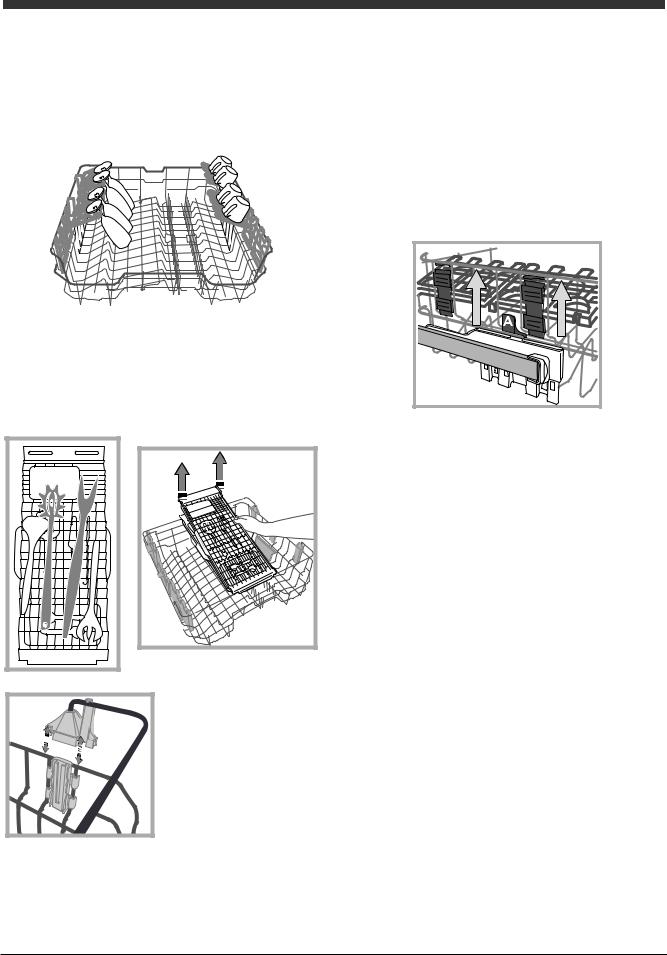
EN |
Tip-up compartments with adjustable position |
|||||
The side tip-up compartments can be positioned at three |
||||||
|
||||||
|
different heights to optimize the arrangement of crockery inside |
|||||
|
||||||
|
the rack. |
|||||
|
Wine glasses can be placed safely in the tip-up compartments |
|||||
|
by inserting the stem of each glass into the corresponding slots. |
|||||
|
|
|
|
|
|
|
|
|
|
|
|
|
|
|
|
|
|
|
|
|
|
|
|
|
|
|
|
Cutlery tray*
Some dishwasher models are fitted with a sliding tray which can be used to hold serving utensils or small cups. For optimum washing performance, avoid positioning bulky crockery directly below the tray.
The cutlery tray can be removed (see Figure).
Before loading the tray, make sure the supports are properly coupled to the upper rack
(see Figure).
Theupperrackcanbeadjustedforheightbasedonrequirements: high position to place bulky crockery in the lower rack and low position to make the most of the tip-up compartments/sectors by creating more space upwards.
Adjusting the height of the upper rack
In order to make it easier to arrange the crockery, the upper rack may be moved to a higher or lower position.
The height of the upper rack should be adjusted WHEN THE RACK IS EMPTY.
NEVER raise or lower the rack on one side only.
If the rack is equipped with a Lift-Up device* (see figure), lift it up by holding its sides. To restore the lower position, press the levers (A) at the sides of the rack and follow the rack down.
Unsuitable crockery
•Wooden crockery and cutlery.
•Delicate decorated glasses, artistic handicraft and antique crockery. Their decorations are not resistant.
•Parts in synthetic material which do not withstand high temperatures.
•Copper and tin crockery.
•Crockery soiled with ash, wax, lubricating grease or ink. The colours of glass decorations and aluminium/silver pieces can change and fade during the washing process. Some types of glass (e.g. crystal objects) can become opaque after a number
of wash cycles too.
Damage to glass and crockery
Caused by:
•Type of glass and glass production process.
•Chemical composition of detergent.
•Water temperature of rinse cycle.
Tips:
•Only use glasses and porcelain guaranteed by the manufacturer as dishwasher safe.
•Use a delicate detergent suitable for crockery.
•Collect glasses and cutlery from the dishwasher as soon as the wash cycle is over.
* Only available in selected models.
8
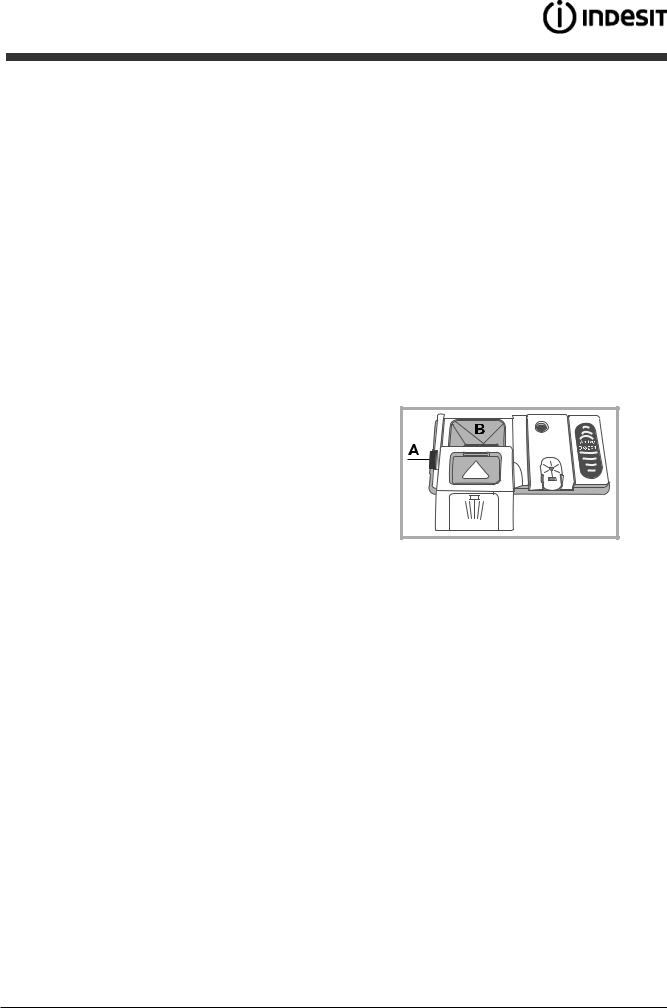
Start-up and use
Starting the dishwasher
1.Turn the water tap on.
2.Switch on the appliance by pressing the ON/OFF button.
3.Open the door and pour in a suitable amount of detergent
(see Measuring out the detergent).
4.Load the racks (see Loading the racks) and shut the door.
5.Select the wash cycle by turning the SELECT WASH CYCLE knob: align the notch on the knob with the number or symbol representing the desired wash cycle. The START/PAUSE indicator light will go on.
6.Select the wash options* (see Options and Special Wash
Cycles).
7.Start the cycle by pressing the START button; the indicator light will stop flashing and stay lit (fixed light). The indicator light corresponding to the wash phase will go on, signalling that the wash cycle has begun.
8.At the end of the wash cycle the END indicator light will go on (fixed light). Switch off the appliance by pressing the ON/OFF button, shut off the water tap and unplug the appliance from the electricity socket.
9.Wait a few minutes before removing the crockery to avoid getting burnt. Unload the racks, beginning with the lower level.
 - The machine will switch off automatically during long periods of inactivity in order to minimise electricity consumption.
- The machine will switch off automatically during long periods of inactivity in order to minimise electricity consumption.
 AUTO WASH CYCLES*: some models of dishwasher are equipped with a special sensor which can be used to assess the level of soiling and automatically select the most efficient and economic wash cycle accordingly. The duration of the auto wash cycles may vary due to the operation of the sensor.
AUTO WASH CYCLES*: some models of dishwasher are equipped with a special sensor which can be used to assess the level of soiling and automatically select the most efficient and economic wash cycle accordingly. The duration of the auto wash cycles may vary due to the operation of the sensor.
Changing a wash cycle in progress
If a mistake was made in the wash-cycle selection process, it is possible to change the cycle provided that it has only just begun: once the wash cycle has started, in order to change the wash cycle switch off the machine by pressing and holding the ON/ OFF/Reset button. Switch it back on using the same button and select the desired wash cycle and options.
Adding extra crockery
Press the Start/Pause button and open the door, taking care to avoid the escaping steam, and place the crockery inside the dishwasher. Press the Start/Pause button: The cycle will start again after a long beep has been emitted.
 If the delayed start has been set, at the end of the countdown the wash cycle will not start. It will stay in Pause mode.
If the delayed start has been set, at the end of the countdown the wash cycle will not start. It will stay in Pause mode.
 Press the Start/Pause button to pause the machine; the wash cycle is stopped.
Press the Start/Pause button to pause the machine; the wash cycle is stopped.
At this stage the wash cycle cannot be changed.
Accidental interruptions
If the door is opened during the wash cycle or there is a power cut, the cycle stops. It starts again from the point at which it was interrupted once the door has been shut or the electricity supply restored.
* Only available in selected models.
Measuring out the detergent |
|
|
EN |
||
A good wash result also depends on the correct |
||
|
||
amount of detergent being used. Exceeding the stated |
|
|
amount does not result in a more effective wash and |
|
|
increases environmental pollution. |
|
Based on how soiled the items are, the amount can be adjusted to individual cases using powder or liquid detergent.
In the case of normally soiled items, use approximately either 35 gr (powder detergent) or 35 ml (liquid detergent). If tablets are used, one tablet will be enough.
If the crockery is only lightly soiled or if it has been rinsed with water before being placed in the dishwasher, reduce the amount of detergent used accordingly.
For good washing results also follow the instructions shown on the detergent box.
For further questions please ask the detergent producers' Advice Offices.
To open the detergent dispenser use the opening device “A”.
Introduce the detergent into the dry dispenser “B” only. Place the amount of detergent for pre-washing directly inside the tub.
1.When measuring out the detergent refer to the Table of wash cycles to add the proper quantity. Compartment B comprises a level showing the maximum quantity of liquid or powder detergent that can be added to each cycle.
2.Remove detergent residues from the edges of the dispenser and close the cover until it clicks.
3.Close the lid of the detergent dispenser by pulling it up until the closing device is secured in place.
The detergent dispenser automatically opens up at the right time according to the wash cycle.
If all-in-one detergents are used, we recommend using the TABS option, because it adjusts the cycle so that the best washing and drying results are always achieved.
 Only use detergent which has been specifically designed for dishwashers.
Only use detergent which has been specifically designed for dishwashers.
DO NOT USE washing-up liquid.
Using excessive detergent may result in foam residue remaining in the machine after the cycle has ended.
The use of tablets is only recommended for models which offer the MULTI-FUNCTIONAL TABLETS option.
To achieve the best results from each washing and drying cycle, powder detergent, liquid rinse aid and salt should be used.
9

Wash cycles
|
|
|
|
|
|
|
|
|
|
|
|
|
Wash-cycle data is measured under laboratory conditions according to European Standard EN 50242. |
|
|
||||||
EN |
|
|
|
|||||||
|
Based on the different conditions of use, the wash-cycle duration and data can change. |
|
|
|||||||
|
|
|
|
|||||||
|
|
|
The number and type of wash cycles and options may vary depending on the dishwasher model. |
|
|
|||||
|
|
|
|
|
||||||
|
|
|
|
|
||||||
|
|
|
|
|
|
|
|
|
|
|
|
|
|
|
|
|
Wash Cycle |
Water |
|
Energy |
|
|
|
|
Wash Cycle |
Drying |
Options |
Consumption (l/ |
|
Consumption |
|
|
|
|
|
Duration |
|
|
|||||
|
|
|
|
|
|
cycle) |
|
(kWh/cycle) |
|
|
|
|
|
|
|
|
|
|
|
||
|
|
1. |
Eco |
Yes |
No |
03:10’ |
11 |
|
1,04 |
|
|
|
|
|
|
|
|
|
|
|
|
|
|
2. |
Intensive |
Yes |
No |
02:30’ |
16,5 |
|
1,65 |
|
|
|
|
|
|
|
|
|
|
|
|
|
|
3. |
Normal |
Yes |
No |
02:00’ |
16,0 |
|
1,3 |
|
|
|
|
|
|
|
|
|
|
|
|
|
|
4. |
Rapid 40’ |
No |
No |
00:40’ |
9,0 |
|
0,9 |
|
|
|
|
|
|
|
|
|
|
|
|
|
|
5. |
Prewash |
No |
No |
00:10’ |
4 |
|
0,01 |
|
|
|
|
|
|
|
|
|
|
|
|
Instructions on wash-cycle selection and detergent dosage
1. The ECO wash cycle is the standard cycle to which the energy label data refers. It can be used to wash crockery with a normal soil level and is the most efficient cycle in terms of energy and water consumption for this type of crockery.
27 gr/ml + 6 gr/ml** – 1 Tab (**Quantity of pre-washing detergent)
2.Heavily soiled dishes and pans (not to be used for delicate items). 30 gr/ml – 1 Tab
3.Normally soiled pans and dishes. 27 gr/ml + 6 gr/ml** – 1 Tab
4.Fast cycle to be used for slightly dirty dishes (ideal for 2 place settings) 25 gr/ml – 1 Tab
5.Pre-wash while awaiting completion of the load with the dishes from the next meal. No detergent.
Standby consumption: Left-on mode consumption: 5,0 W - Off mode consumption: 0.5 W
Notes:
Optimum performance levels when using the “Rapid 40’” cycle can be achieved by respecting the specified number of place settings.
To reduce consumption, only run the dishwasher when it is full.
Note for Test Laboratories: for information on comparative EN testing conditions, please send an email to the following address: assistenza_en_lvs@indesitcompany.com
10
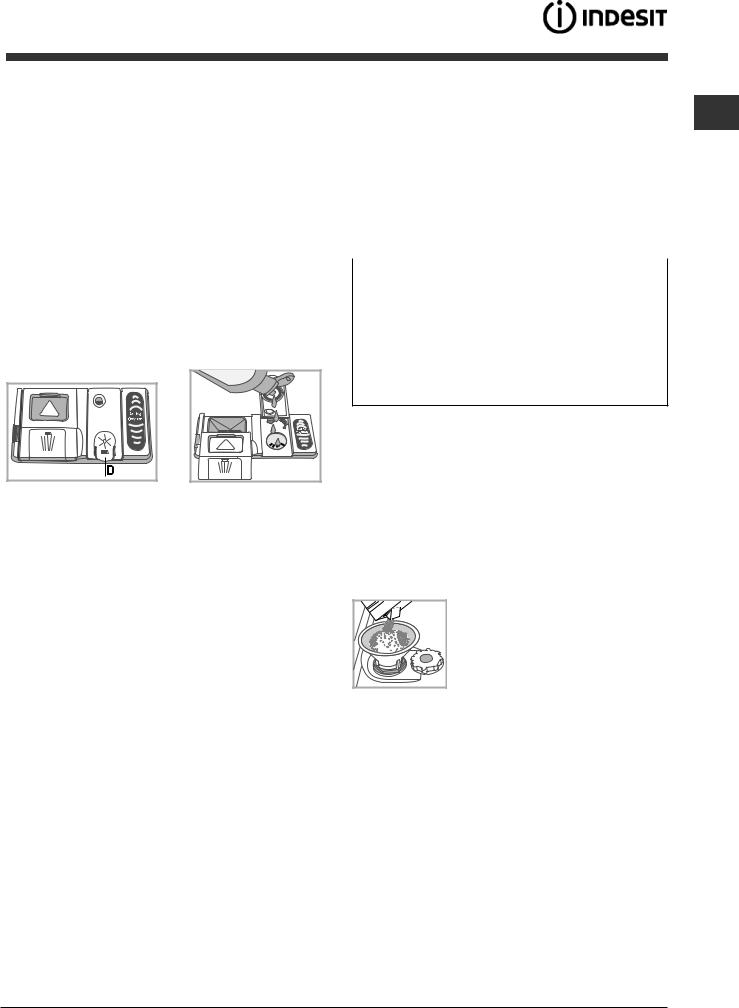
Rinse aid and refined salt
 Only use products which have been specifically designed for dishwashers.
Only use products which have been specifically designed for dishwashers.
Do not use table/industrial salt or washing-up liquid. Follow the instructions given on the packaging.
 If using a multi-functional product it is not necessary to add any rinse aid. However, we recommend that you add salt, especially if you live in an area where the water is hard or very hard. (Follow the instructions given on the packaging).
If using a multi-functional product it is not necessary to add any rinse aid. However, we recommend that you add salt, especially if you live in an area where the water is hard or very hard. (Follow the instructions given on the packaging).
 If you do not add salt or rinse aid, the LOW SALT* and LOW RINSE AID indicator lights will stay lit.
If you do not add salt or rinse aid, the LOW SALT* and LOW RINSE AID indicator lights will stay lit.
Measuring out the rinse aid
Rinse aid makes it easier for the crockery to dry, as water runs off the surfaces more readily and therefore does not leave streaks or marks. The rinse aid dispenser should be filled:
•When the LOW RINSE AID indicator light* on the control panel is illuminated, a reserve supply of rinse aid is still available for 1-2 cycles;
A |
X |
M |
1.Open the dispenser “D” by pressing and pulling up the tab on the lid;
2.Carefully introduce the rinse aid as far as the maximum reference notch of the filling space - avoid spilling it. If this happens, clean the spill immediately with a dry cloth.
3.Press the lid down until you hear a click to close it.
NEVER pour the rinse aid directly into the appliance tub.
Adjusting the amount of rinse aid
If you are not completely satisfied with the drying results, you can adjust the quantity of rinse aid. Switch on the dishwasher using the ON/OFF button, wait a few seconds and switch it off using the ON/OFF button. Press the Start/Pause button 3 times; switch on the machine using the ON/OFF button and access the adjustment menu - the rinse-aid indicator light is lit (set to factory level).
Adjust the level of rinse aid supply using the WASH CYCLE SELECT knob. There is a rinse aid level for each wash cycle (0 to 4 max).
Press the ON/OFF button to save the setting.
If the rinse aid level is set to ZERO (ECO), no rinse aid will be supplied. The LOW RINSE AID indicator light will not be lit if you run out of rinse aid.
•If there are streaks on the crockery, set a low number (1-2).
•If there are drops of water or limescale marks, set a high number (3-4).
Setting the water hardness
Every dishwasher is equipped with a water softener which, by using refined salt designed specially for this type of appliance, supplies water without limescale which is then used to wash the crockery.
This dishwasher has a setting that helps reduce pollution and optimises washing performance in accordance with the water hardness level in your area. Ask your local water supplier for
this information.
- Switch on the dishwasher using the ON/OFF button, wait a EN few seconds and switch it off using the ON/OFF button. Hold
down the Start/Pause button for min. 3 seconds; switch on the machine using the ON/OFF button and access the adjustment menu - the salt indicator light is lit.
-Select the desired level using the SELECT WASH CYCLE knob
(1 to 5* Max.)
(water softener set to medium level).
Press the ON/OFF button to save the setting.
Even if using multi-functional tablets, fill the salt dispenser.
Water Hardness Table |
|
Average salt dispenser |
|||
|
capacity duration** |
||||
level |
°dH |
°fH |
mmol/l |
months |
|
1 |
0 |
- 6 |
0 - 10 |
0 - 1 |
7 months |
2 |
6 - 11 |
11 - 20 |
1,1 - 2 |
5 months |
|
3 |
12 |
- 17 |
21 - 30 |
2,1 - 3 |
3 months |
4 |
17 |
- 34 |
31 - 60 |
3,1 - 6 |
2 months |
5* |
34 |
- 50 |
61 - 90 |
6,1 - 9 |
2/3 weeks |
For values between 0°f and 10°f, we do not recommend the use of salt. * a setting of 5 may increase cycle duration.
** 1 wash cycle per day.
(°dH = hardness measured in German degrees - °f = hardness measured in French degrees – mmol/l = millimoles per litre)
Measuring out the refined salt
In order to obtain the best possible results from a wash cycle, make sure that the salt dispenser is never empty.
Refined salt removes limescale from the water, thus avoiding the formation of deposits on crockery.
The salt dispenser is located in the lower part of the dishwasher (see Description) and should be filled:
•When the green float* cannot be seen by simply looking at the cap of the salt dispenser;
•When the LOW RINSE AID indicator
light on the control panel is illuminated *;
1. Remove the lower rack and unscrew
the cap (anticlockwise).
2. The first time you do this: fill the water
tank right up to its edge.
3. Position the funnel* (see figure) and fill the salt dispenser up to the edge
(approximately 1 kg). It is normal for a little water to leak out. 4. Remove the funnel* and wipe any salt residues away from the opening; rinse the cap under running water and then screw it on, the head facing downwards so as to let the water flow out of the four slots (star-shaped arrangement) in the lower part of
the cap (cap with green float*).
It is advisable to perform this procedure every time you add salt to the dispenser.
Make sure the cap is screwed on tightly so that no detergent can get into the container during the wash cycle (this could damage the water softener beyond repair).
 When necessary, measure out the salt before a wash cycle so that any saline solution which has leaked out of the salt dispenser is removed.
When necessary, measure out the salt before a wash cycle so that any saline solution which has leaked out of the salt dispenser is removed.
* Only available in selected models.
11

Care and maintenance
EN
Shutting off the water and electricity |
|
supplies |
|
• |
Turn off the water tap after every wash cycle to avoid leaks. |
• |
Always unplug the appliance when cleaning it and when |
|
performing maintenance work. |
Cleaning the dishwasher |
|
• |
The external surfaces of the machine and the control panel |
|
can be cleaned using a non-abrasive cloth which has been |
|
dampened with water. Do not use solvents or abrasive |
|
products. |
• |
Any marks on the inside of the appliance may be removed |
|
using a cloth dampened with water and a little vinegar. |
Preventing unpleasant odours |
|
• |
Always keep the door of the appliance ajar in order to avoid |
|
moisture from forming and being trapped inside the machine. |
• |
Clean the seals around the door and detergent dispensers |
|
regularly using a damp sponge. This will avoid food becoming |
|
trapped in the seals, which is the main cause behind the |
|
formation of unpleasant odours. |
Cleaning the sprayer arms |
|
Food residue may become encrusted onto the sprayer arms |
|
and block the holes used to spray the water. It is therefore |
|
recommended that you check the arms from time to time and |
|
clean them with a small non-metallic brush. |
|
The two sprayer arms may both be removed. |
|
|
To remove the upper sprayer arm, |
|
turn the plastic locking ring in an |
|
anti-clockwise direction. The upper |
|
sprayer arm should be replaced |
|
so that the side with the greater |
|
number of holes is facing upwards. |
The lower sprayer arm can be |
removed by pressing on the side |
tabs and pulling it upwards. |
Cleaning the water inlet filter* |
If the water hoses are new or have not been used for an extended period of time, let the water run to make sure it is clear and free of impurities before performing the necessary connections. If this precaution is not taken, the water inlet could become blocked and damage the dishwasher.
Clean the water inlet filter at the tap outlet regularly.
-Turn off the water tap.
-Unscrew the end of the water inlet hose, remove the filter and clean it carefully under running water.
-Re-place the filter and screw the water hose back into position.
Cleaning the filters
The filter assembly consists of three filters which remove food residues from the washing water and then recirculate the water. They should be cleaned if you wish to achieve the best results in every wash.
 Clean the filters regularly.
Clean the filters regularly.
 The dishwasher should not be used without filters or if the filter is loose.
The dishwasher should not be used without filters or if the filter is loose.
• After several washes, check the filter assembly and if necessary clean it thoroughly under running water, using a non-metallic brush and following the instructions below:
1.Turn the cylindrical filter C in an anti-clockwise direction and pull it out (fig. 1).
2.Remove the cup filter B by exerting a slight pressure on the side flaps (fig. 2);
3.Slide out the stainless-steel plate filter A. (fig. 3).
4.Inspect the trap and remove any food residues. NEVER
REMOVE the wash-cycle pump protection (black detail) (fig.4).
After cleaning the filters, re-place the filter assembly and fix it in position correctly; this is essential for maintaining the efficient operation of the dishwasher.
Leaving the machine unused for extended periods
•Disconnect the appliance from the electricity supply and shut off the water tap.
•Leave the door of the appliance ajar.
•When you return, run a wash cycle when the dishwasher is empty.
* Only available in selected models.
12

Troubleshooting
|
|
|
|
|
Whenever the appliance fails to work, check for a solution from the following list before calling for Assistance. |
|
|||
EN |
||||
|
|
|
||
|
|
|
|
|
Problem: |
Possible causes / solutions: |
|
|
|
The dishwasher cannot be started or |
• Switch off the appliance by pressing the ON/OFF button. Switch it back on |
|
|
|
controlled. |
after approximately one minute and reset the program. |
|
|
|
|
• The appliance has not been plugged in properly. |
|
|
|
|
• The dishwasher door has not been shut properly. |
|
|
|
The door won’t close. |
• The lock was released. Strongly push the door until a “clacking” noise is |
|
|
|
heard. |
|
|
||
|
|
|
||
No water drains from the |
• The dishwasher cycle has not finished yet. |
|
|
|
dishwasher. |
• The water drain hose is bent (see Installation). |
|
|
|
|
• The drain duct is blocked. |
|
|
|
|
• The filter is clogged up with food residues. |
|
|
|
The dishwasher is too noisy. |
• The dishes are rattling against each other or against the sprayer arms. |
|
|
|
|
• An excessive amount of foam has been produced: the detergent has not been |
|
|
|
|
measured out correctly or it is not suitable for use in dishwashers (see Start- |
|
|
|
|
up and use). |
|
|
|
The dishes and glasses are |
• The level of refined salt is low or the dosage setting is not suited to the |
|
|
|
covered in a white film or |
hardness of the water (see Rinse aid and salt). |
|
|
|
limescale deposits. |
• The lid on the salt dispenser was not closed properly. |
|
|
|
|
• The rinse aid has been used up or the dosage is too low. |
|
|
|
The dishes and glasses are |
• The rinse aid dosage is too high. |
|
|
|
streaked or have a bluish |
|
|
|
|
tinge. |
|
|
|
|
The crockery has not been |
• A wash cycle without a drying cycle has been selected. |
|
|
|
dried properly. |
• The rinse aid has been used up or the dosage is too low (see Ri nse aid and |
|
|
|
|
salt). |
|
|
|
|
• The rinse aid setting is not suitable. |
|
|
|
|
• The crockery is made from non-stick material or plastic. |
|
|
|
The crockery is not clean. |
• The racks are overloaded (see Loading the racks.) |
|
|
|
|
• The crockery has not been arranged properly. |
|
|
|
|
• The sprayer arms cannot move freely. |
|
|
|
|
• The wash cycle is too gentle (see Wash cycles). |
|
|
|
|
• An excessive amount of foam has been produced: the detergent has not been |
|
|
|
|
measured out correctly or it is not suitable for use in dishwashers (see Start- |
|
|
|
|
up and use). |
|
|
|
|
• The lid on the rinse aid compartment was not shut correctly. |
|
|
|
|
• The filter is dirty or blocked (see Care and maintenance). |
|
|
|
|
• The refined salt level is low (see Rinse aid and salt). |
|
|
|
The dishwasher does not take |
• There is no water in the mains supply. |
|
|
|
any water in - Tap shut-off |
• The water inlet hose is bent (see Installation). |
|
|
|
alarm. |
• Turn on the tap and the appliance will start after a few minutes. |
|
|
|
(The Drying and End indicator lights |
• The appliance stopped because no action was taken when the beep |
|
|
|
flash quickly.) |
sounded*. (*Only available on selected models.) |
|
|
|
|
Switch off the machine using the ON/OFF button, turn on the tap and switch |
|
|
|
|
the machine back on after 20 seconds by pressing the same button. Reset the |
|
|
|
|
appliance and restart the wash cycle. |
|
|
|
* Only available in selected models.
13

Mode d’emploi
FR
Français, 14
DFG 15B1
LAVE-VAISSELLE
Sommaire
Fiche de produit, 15
Précautions et conseils, 16-17
Sécurité générale
Mise au rebut
Economies et respect de l’environnement
Service
Installation, 18-19
Mise en place et mise à niveau
Raccordements eau et électricité
Conseils pour le premier lavage
Caractéristiques techniques
Transport
Description de l’appareil, 20
Vue d’ensemble
Tableau de bord
Charger les paniers, 21-22
Panier inférieur
Panier à couverts
Panier supérieur
Clayettes rabattables
Régler la hauteur du panier supérieur
Vaisselle non appropriée
Mise en marche et utilisation, 23
Mettre en marche le lave-vaisselle Charger le produit de lavage
Programmes, 24
Tableau des programmes
Produit de rinçage et sel régénérant, 25
Charger le produit de rinçage Charger le sel régénérant
Entretien et soin, 26
Coupure de l’arrivée d’eau et de courant Nettoyer le lave-vaisselle
Eviter les mauvaises odeurs Nettoyer les bras de lavage Nettoyage du filtre d’entrée d’eau Nettoyer les filtres
En cas d’absence pendant de longues périodes
Anomalies et remèdes, 27
14

Fiche de produit
|
|
|
|
|
|
|
|
|
|
|
FR |
Fiche de produit |
|
|
|
|
|
|
|
|
|
|
|
Marque |
INDESIT |
|
|
|
|
|
|
Modèle |
DFG 15B1 |
|
|
|
|
|
|
Capacité nominale dans un environnement standard (1) |
13 |
|
|
|
|
|
|
Classe énergétique sur une échelle de A+++ (faible consommation) à D (consommation élevée) |
A+ |
|
|
|
|
|
|
Consommation d''énergie par année en kWh (2) |
295.0 |
|
|
|
|
|
|
Consommation d''énergie du cycle de lavage standard en kWh |
1.04 |
|
|
|
|
|
|
Consommation d''energie en mode "off" en W |
0.5 |
|
|
|
|
|
|
Consommation d''energie en mode "on" en W |
5.0 |
|
|
|
|
|
|
Consommation d''eau par an en litres (3) |
3080.0 |
|
|
|
|
|
|
Classe d’efficacité du séchage sur une échelle de G (efficacité minimum) à A (efficacité maximum) |
A |
|
|
|
|
|
|
Durée du programme pour un cycle de lavage standard en minutes |
190 |
|
|
|
|
|
|
Durée du mode "on" en minutes |
10 |
|
|
|
|
|
|
Émissions acoustiques dans l’air, exprimées en dB(A) re 1 pW |
49 |
|
|
|
|
|
|
Encastrable |
Non |
|
|
|
|
|
|
|
|
|
|
Remarque |
|
|
|
|
|
||
1) Les informations sur l’étiquette et sur la fiche se rapportent au cycle de lavage standard. Ce programme convient pour laver une |
|
|
|
vaisselle normalement sale, et il s’agit des programmes les plus efficaces en termes de consommation combinée d’eau et d’énergie. Le |
|
||
cycle de lavage standard correspond au cycle éco. |
|
|
|
|
|
||
2) Sur la base de 280 cycles de lavage standard avec une alimentation en eau froide et une consommation en modes à faible |
|
|
|
puissance. La consommation réelle d’énergie dépend des conditions d’utilisation de l’appareil. |
|
|
|
|
|
||
3) Sur la base de 280 cycles de lavage standard. La consommation réelle d’énergie dépend des conditions d’utilisation de l’appareil. |
|
|
|
|
|
|
|
15

Précautions et conseils
FR |
Cet appareil a été conçu et fabriqué |
|
conformément aux normes internationales de |
|
sécurité. Ces consignes sont fournies pour des |
|
raisons de sécurité, il faut les lire attentivement. |
|
Conserver ce mode d’emploi pour pouvoir le |
|
consulter à tout moment. En cas de vente, de |
|
cession ou de déménagement, s’assurer qu’il |
|
accompagne bien l’appareil. |
|
Lire attentivement les instructions : elles fournissent |
|
des conseils importants sur l’installation, l’utilisation |
|
et la sécurité de l’appareil. |
Cet appareil est conçu pour un usage domestique ou autres applications similaires, telles que :
-lieux aménagés en espace cuisine pour le personnel de magasins, bureaux et autres lieux de travail ;
-fermes ;
-utilisation par les clients d’hôtels, de motels ou autres locaux de type résidentiel ;
-chambres d’hôtes.
Sécurité générale
•Cet électroménager n'est pas destiné à être utilisé par des personnes (enfants compris) dont les capacités physiques, sensorielles ou mentales sont réduites ou qui ne disposent pas des connaissances ou de l'expérience nécessaires, à moins qu'elles n'aient été formées et encadrées pour l'utilisation de cet appareil par une personne responsable de leur sécurité.
•Les enfants doivent être surveillés par un adulte pour éviter qu’ils ne jouent avec l’appareil.
•Cet appareil est conçu pour un usage de type non professionnel à l'intérieur d'une habitation.
•Cet appareil est destiné au lavage de vaisselle à usage domestique, il ne doit être utilisé que par des adultes et selon les instructions reportées dans cette notice.
•Ne pas installer l’appareil à l’extérieur, même dans un endroit protégé, car il est extrêmement dangereux de l’exposer à la pluie et aux orages.
•Ne pas toucher au lave-vaisselle pieds nus.
•Ne jamais tirer sur le câble pour débrancher la fiche de la prise de courant.
•Fermer le robinet de l’eau et débrancher la fiche de la prise de courant avant d’effectuer tous travaux de nettoyage et d’entretien.
•En cas de panne, éviter à tout prix d’accéder aux mécanismes internes pour tenter une réparation.
•Ne pas s’appuyer à la porte ouverte ou s’y asseoir : l’appareil pourrait basculer.
•Ne pas garder la porte ouverte pour éviter de buter contre elle en risquant de se faire mal.
•Garder les produits de lavage et de rinçage hors de la portée des enfants.
•Les emballages ne sont pas des jouets pour enfants.
Mise au rebut
•Mise au rebut du matériel d’emballage : se conformer aux réglementations locales de manière à ce que les emballages puissent être recyclés.
•La directive européenne 2012/19/EU sur les déchets d’équipements électriques et électroniques (DEEE), prévoit que les
électroménagers ne peuvent pas être traités comme des déchets solides urbains normaux.
Les appareils usagés doivent être collectés séparément afin d’optimiser le taux de récupération et le recyclage des matériaux qui les composent et réduire l’impact sur la santé humaine et l’environnement Le symbole de la poubelle barrée est appliqué sur tous les produits pour rappeler qu’ils font l’objet d’une collecte sélective.
Pour tout autre renseignement sur la collecte des électroménagers usés, prière de s’adresser au service public préposé ou au vendeur.
Economies et respect de l’environnement
Faire des économies d’eau et d’électricité
•Ne faire fonctionner le lave-vaisselle que quand il est rempli au maximum de sa capacité. Dans l’attente de remplir l’appareil, lancer le cycle de Trempage pour éviter la formation de mauvaises odeurs (voir Programmes).
•Sélectionner un programme adapté au type de vaisselle et à son degré de salissure, consulter pour cela le Tableau des programmes :
-pour de la vaisselle normalement sale, choisir le programme Eco (économique), il limite la quantité d’eau et d’électricité utilisée.
-pour une quantité réduite de vaisselle, choisir
l’option Demi-charge* (voir Mise en marche et utilisation).
•Si le contrat de fourniture d’électricité prévoit des tranches horaires à prix réduit, effectuer les lavages pendant ces heures creuses. L’option Départ différé* (voir Mise en marche et utilisation) peut vous aider à organiser vos lavages dans ce sens.
*Présent uniquement sur certains modèles.
16

Produits de lavage sans phosphates, sans chlore et aux enzymes
•Il est vivement conseillé d’utiliser des produits de lavage sans phosphates et sans chlore, plus indiqués pour la protection de l’environnement.
•Les enzymes développent une action particulièrement efficace à des températures avoisinant 50°C, les produits de lavage aux enzymes permettent donc de sélectionner des lavages à de basses températures et d’obtenir les mêmes résultats qu’à une température de 65°C.
•Pour bien doser le produit de lavage, il faut tenir compte des indications du fabricant, de la dureté de l’eau, de la quantité de vaisselle et de son degré de salissure pour éviter tout gaspillage. Bien que biodégradables, les produits de lavage contiennent des éléments qui altèrent l’équilibre de la nature.
Service FR
Avant d’appeler le service d’assistance technique:
•Vérifier s’il est possible de résoudre l’anomalie soimême (voir Anomalies et remèdes).
•Faire repartir le programme pour s’assurer que l’inconvénient a été résolu.
•Si ce n’est pas le cas, contacter un Service d’Assistance
Technique agréé.
 Ne jamais faire appel à des techniciens non agréés.
Ne jamais faire appel à des techniciens non agréés.
Communiquer:
•le type d’anomalie;
•le modèle de l’appareil (Mod.);
•le numéro de série (S/N).
Ces informations figurent sur la plaque signalétique apposée sur l’appareil (voir Description de l’appareil).
17
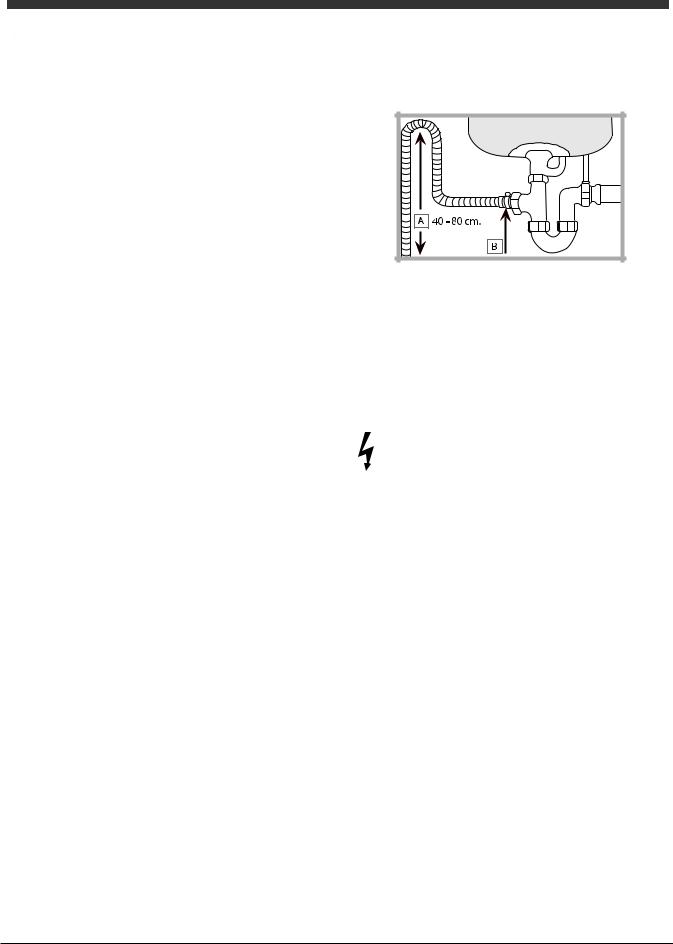
Installation
FR |
|
|
En cas de déménagement, transporter l’appareil |
|
|
||
|
verticalement; si besoin est, l’incliner sur le dos. |
||
|
|
||
|
|
|
|
Mise en place et mise à niveau
1.Déballer l’appareil et s’assurer qu’il n’a pas été endommagé pendant le transport. S’il est abîmé, ne pas le raccorder et contacter le revendeur.
2.Installer le lave-vaisselle de manière à ce que les côtés et
la paroi arrière touchent aux meubles adjacents ou au mur.
L’appareil peut être encastré sous un plan de travail continu*
(voir feuille de montage).
3.Installer le lave-vaisselle sur un sol plat et rigide. Compenser les irrégularités en vissant ou en dévissant les pieds avant jusqu'à ce que l'horizontalité de l’appareil soit parfaite. Une bonne horizontalité garantit la stabilité de l’appareil et supprime tout risque de vibrations, bruits et déplacements.
4*. Pour régler la hauteur du pied arrière, agir sur la douille rouge à six pans située dans la partie avant du lave-vaisselle, en bas et au milieu, à l’aide d’une clé mâle à six pans, ouverture 8 mm.
Tourner dans le sens des aiguilles d’une montre pour augmenter la hauteur et dans le sens inverse pour la diminuer. (voir feuille d’instructions jointe à la documentation)
Raccordements eau et électricité
 L’adaptation des installations électriques et les travaux de plomberie de l’installation doivent être effectués par du personnel qualifié.
L’adaptation des installations électriques et les travaux de plomberie de l’installation doivent être effectués par du personnel qualifié.
 Le lave-vaisselle ne doit pas écraser les tuyaux ou le câble d’alimentation électrique.
Le lave-vaisselle ne doit pas écraser les tuyaux ou le câble d’alimentation électrique.
 Utiliser des tuyaux neufs pour effectuer le raccordement de l’appareil au réseau de distribution de l’eau.
Utiliser des tuyaux neufs pour effectuer le raccordement de l’appareil au réseau de distribution de l’eau.
Ne pas réutiliser les anciens tuyaux.
Les tuyaux d’amenée et d’évacuation de l’eau et le câble d’alimentation électrique peuvent être orientés vers la droite ou vers la gauche pour simplifier l’installation.
Raccord du tuyau d’amenée de l’eau
•A une prise d'eau froide : bien visser le tuyau d’amenée à un robinet à embout fileté 3/4 gaz ; avant de visser, faire couler l’eau jusqu’à ce quelle devienne limpide et dépourvue d’impuretés qui pourraient engorger l’appareil.
•A une prise d'eau chaude : en cas d’installation de chauffage centralisé (radiateurs), le lave-vaisselle peut être alimenté avec de l’eau chaude de réseau ne dépassant pas 60°C.
Visser le tuyau au robinet en procédant comme pour la prise d'eau froide.
 Si la longueur du tuyau d’amenée ne suffit pas, s’adresser à un magasin spécialisé ou à un technicien agréé (voir Assistance).
Si la longueur du tuyau d’amenée ne suffit pas, s’adresser à un magasin spécialisé ou à un technicien agréé (voir Assistance).
 La pression de l’eau doit être comprise entre les valeurs reportées dans le tableau des Caractéristiques techniques (voir ci-contre).
La pression de l’eau doit être comprise entre les valeurs reportées dans le tableau des Caractéristiques techniques (voir ci-contre).
Attention à ce que le tuyau ne soit pas plié ou écrasé.
Raccordement du tuyau d’évacuation de l’eau
Raccorder le tuyau d’évacuation, sans le plier, à une conduite d’évacuation ayant au moins 4 cm de diamètre.
Le tuyau d’évacuation doit être placé entre 40 et 80 cm audessus du sol ou du plan d’appui du lave-vaisselle (A).
Avant de raccorder le tuyau d’évacuation de l’eau au siphon de l’évier, retirer le bouchon en plastique (B).
Sécurité anti-fuite
Pour éviter tout risque d’inondation, le lave-vaisselle :
- est équipé d’un dispositif qui coupe l’arrivée de l’eau en cas d’anomalie ou de fuite à l’intérieur de l’appareil.
Quelques modèles sont équipés d’un dispositif de sécurité supplémentaire New Acqua Stop*, qui garantit contre tout risque d'inondation même en cas de rupture du tuyau d’amenée de l’eau.
ATTENTION : TENSION DANGEREUSE !
Il ne faut en aucun cas couper le tuyau d’amenée de l’eau car il contient des parties sous tension.
Raccordement électrique
Avant de brancher la fiche dans la prise de courant, s'assurer que :
•la prise est bien reliée à la terre et est conforme aux réglementations en vigueur ;
•la prise est bien apte à supporter la puissance maximale de la machine reportée sur la plaquette signalétique fixée à la contre-porte
(voir chapitre Description du lave-vaisselle) ;
•a tension d’alimentation est bien comprise entre les valeurs figurant sur la plaque signalétique de la contre-porte ;
•la prise est bien compatible avec la fiche de l’appareil.
Autrement, faire remplacer la fiche par un technicien agréé (voir Assistance) ; n’utiliser ni rallonges ni prises multiples.
 Après installation de l’appareil, le câble d’alimentation électrique et la prise de courant doivent être facilement accessibles.
Après installation de l’appareil, le câble d’alimentation électrique et la prise de courant doivent être facilement accessibles.
 Le câble ne doit être ni plié ni trop écrasé.
Le câble ne doit être ni plié ni trop écrasé.
 Afin d’éviter tout danger, faire changer le cordon d’alimentation abîmé, par le fabricant ou par son service aprèsvente. (Voir Assistance)
Afin d’éviter tout danger, faire changer le cordon d’alimentation abîmé, par le fabricant ou par son service aprèsvente. (Voir Assistance)
* Présent uniquement sur certains modèles.
18

Ruban anti-condensation*
Après avoir encastré le lave-vaisselle, ouvrir la porte et coller le ruban adhésif transparent sous le plan en bois pour le protéger contre la formation de condensation.
Conseils pour le premier lavage
Après l’installation, enlever les chevilles placées sur les paniers et les élastiques de blocage sur le panier supérieur (le cas échéant).
Juste avant le premier lavage, remplir complètement d’eau le réservoir à sel et ajouter environ 1 kg de sel (voir Produit de rinçage et sel régénérant) : il est tout à fait normal que de l’eau déborde. Sélectionner le degré de dureté de l’eau (voir Produit de rinçage et sel régénérant). - Après remplissage du réservoir à sel, le voyant SEL* s’éteint.
 Le manque de remplissage du réservoir à sel, peut endommager l’adoucisseur d’eau et l’élément chauffant.
Le manque de remplissage du réservoir à sel, peut endommager l’adoucisseur d’eau et l’élément chauffant.
Caractéristiques techniques
Dimensions |
largeur 60 cm |
|||
hauteur 85 cm |
||||
|
|
|
profondeur 60 cm |
|
Capacité |
13 couverts standard |
|||
Pression eau |
0,05 ÷ 1 MPa (0,5 ÷ 10 bar) |
|||
d’alimentation |
7,25 – 145 psi |
|||
Tension |
Voir étiquette des caractéristiques |
|||
d’alimentation |
||||
|
||||
Puissance totale |
Voir étiquette des caractéristiques |
|||
absorbée |
|
|||
Fusible |
Voir étiquette des caractéristiques |
|||
|
|
|
Cet appareil est conforme aux |
|
|
|
|
Directives Communautaires suivantes: |
|
|
|
|
- 2006/95/EC (Basse Tension) |
|
|
|
|
- 2004/108/EC (Compatibilité |
|
|
|
|
Electromagnétique) |
|
|
|
|
-2009/125/EC (Comm. Reg. |
|
|
|
|
1016/2010) (Ecodesign) |
|
|
|
|
-97/17/EC (Etiquetage) |
|
|
|
|
-2012/19/EU (DEEE) |
|
|
|
|
||
Cet électroménager dispose de signaux sonores/bips (selon
le modèle de lave-vaisselle) qui signalent que la commande FR a été activée: allumage, fin de cycle etc..
Tous les symboles/voyants/led lumineux du bandeau de commande/afficheur peuvent avoir des couleurs différentes, flasher ou être en fixe. (selon le modèle de lave-vaisselle).
Affichage d'informations utiles concernant le type de cycle sélectionné, la phase de lavage/séchage, le temps résiduel, la température etc.... etc...
19
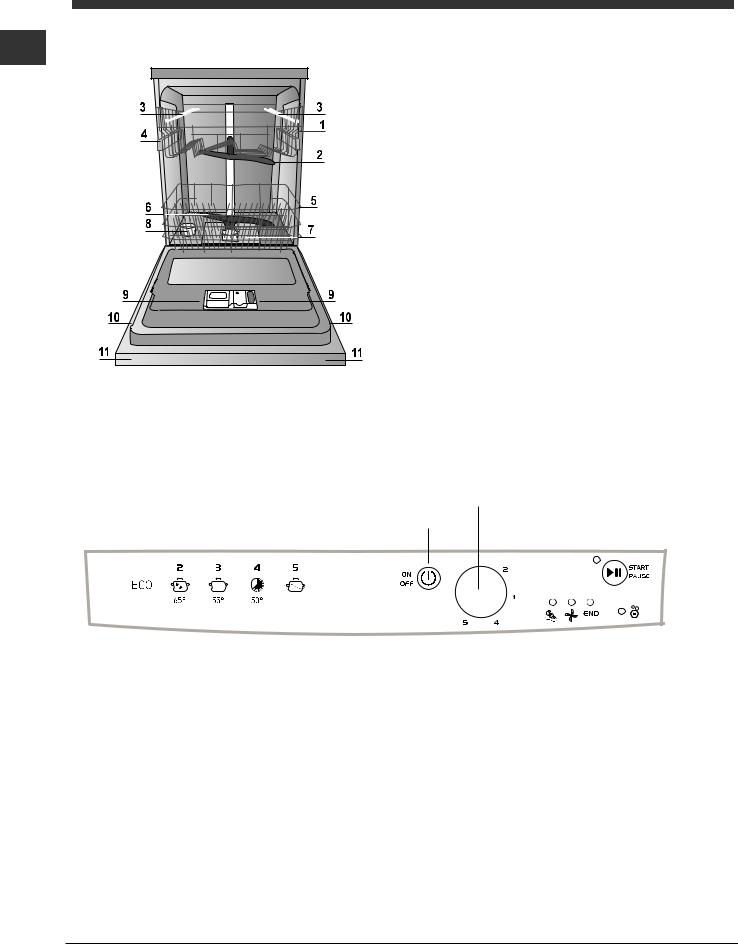
Description de l’appareil
FR |
Vue d’ensemble |
|
1. Panier supérieur
2. Bras de lavage supérieur
3. Clayettes rabattables
4. Réglage hauteur du panier
5. Panier inférieur
6. Bras de lavage inférieur
7. Filtre lavage
8. Réservoir à sel
9. Bacs à produit de lavage, réservoir à produit de rinçage et dispositif Oxygène Actif*
10. Plaque signalétique
11. Bandeau de commandes***
Tableau de bord
|
Touche et voyant |
|
Bouton sélection programmes |
Départ/Pause |
|
|
|
|
Touche On-Off/Reset |
|
|
|
|
|
|
|
|
|
|
|
|
|
|
Voyant sel |
|
Voyant lavage |
|
|
|
||
|
|
|
|
|||
|
|
|
|
|||
|
|
|
|
|||
|
|
|
|
|||
|
|
|
|
|
||
|
|
Voyant séchage |
|
|
|
|
|
Voyant fin de programme |
|
|
|||
*** Uniquement pour modèles « tout intégrable » * Présent uniquement sur certains modèles.
Le nombre et les types de programmes varient selon le modèle de lave-vaisselle.
20
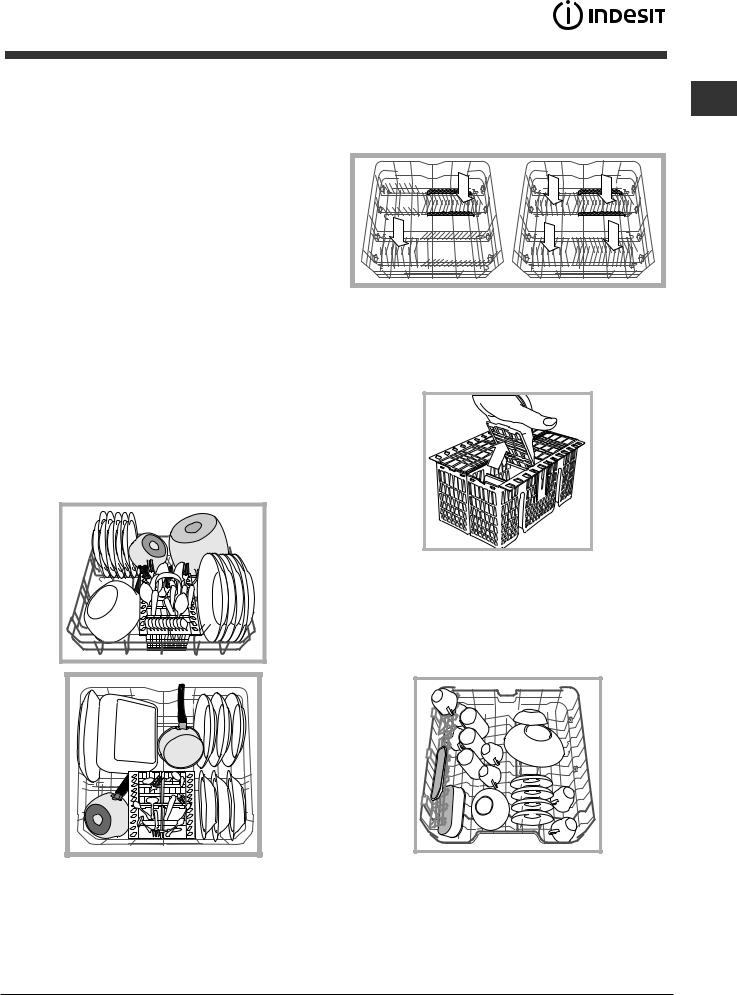
Charger les paniers
Conseils
Avant de charger les paniers, débarrasser la vaisselle des déchets plus importants et vider les verres et autres récipients.
Pas besoin de rincer préalablement à l'eau courante.
Ranger la vaisselle de manière à ce qu’elle ne bouge pas pour éviter tout risque de renversement, ranger les saladiers et les casseroles ouverture tournée vers le bas et les parties concaves ou convexes en position oblique pour permettre à l'eau d'atteindre toutes les surfaces et de s'écouler complètement. Veiller à ce que les couvercles, manches, poêles et plateaux ne gênent pas la rotation des bras de lavage. Placer les petits objets dans le panier à couverts.
La vaisselle en plastique et les poêles anti-adhésives ont tendance à retenir les gouttes d'eau et leur degré de séchage sera par conséquent inférieur à celui de la vaisselle en céramique ou en acier.
Les objets légers (tels que les récipients en plastique) doivent
être rangés, de préférence. dans le panier supérieur et placés de manière à ce qu'ils ne risquent pas de se déplacer.
Après avoir chargé le lave-vaisselle, s’assurer que les bras de lavage tournent librement.
Panier inférieur
Le panier inférieur peut contenir des casseroles, des couvercles, des assiettes, des saladiers, des couverts etc. Les assiettes et les couvercles de grandes dimensions doivent être rangés, de préférence, sur les côtés du panier.
Il est conseillé de ranger la vaisselle très sale dans le panier inférieur car dans cette partie du lave-vaisselle, les jets d'eau sont plus énergiques et permettent d'obtenir de meilleures performances de lavage.
*Présents uniquement sur certains modèles, ils peuvent varier au point de vue nombre et emplacement.
Certains modèles de lave-vaisselle sont pourvus de secteurs rabattables*, qui peuvent être utilisés en position verticale pour FR accueillir les assiettes ou en position horizontale (abaissés) pour
pouvoir charger plus facilement les casseroles et les saladiers.
Panier à couverts
Le panier à couverts est équipé de grilles supérieures permettant de mieux ranger les couverts. Le panier à couverts non séparable doit être placé obligatoirement dans la partie avant du panier inférieur.
 Ranger les couteaux et les ustensiles de cuisine pointus et coupants dans le panier à couverts, pointes tournées vers le bas, ou, à plat, sur les clayettes rabattables du panier supérieur.
Ranger les couteaux et les ustensiles de cuisine pointus et coupants dans le panier à couverts, pointes tournées vers le bas, ou, à plat, sur les clayettes rabattables du panier supérieur.
Panier supérieur
Réservé au chargement de la vaisselle fragile et légère : verres, tasses, soucoupes, saladiers bas.
Certains modèles de lave-vaisselle sont pourvus de secteurs rabattables*, qui peuvent être placés à la verticale pour ranger des assiettes à thé ou à dessert ou abaissés pour ranger des coupes et autres récipients pour aliments.
21
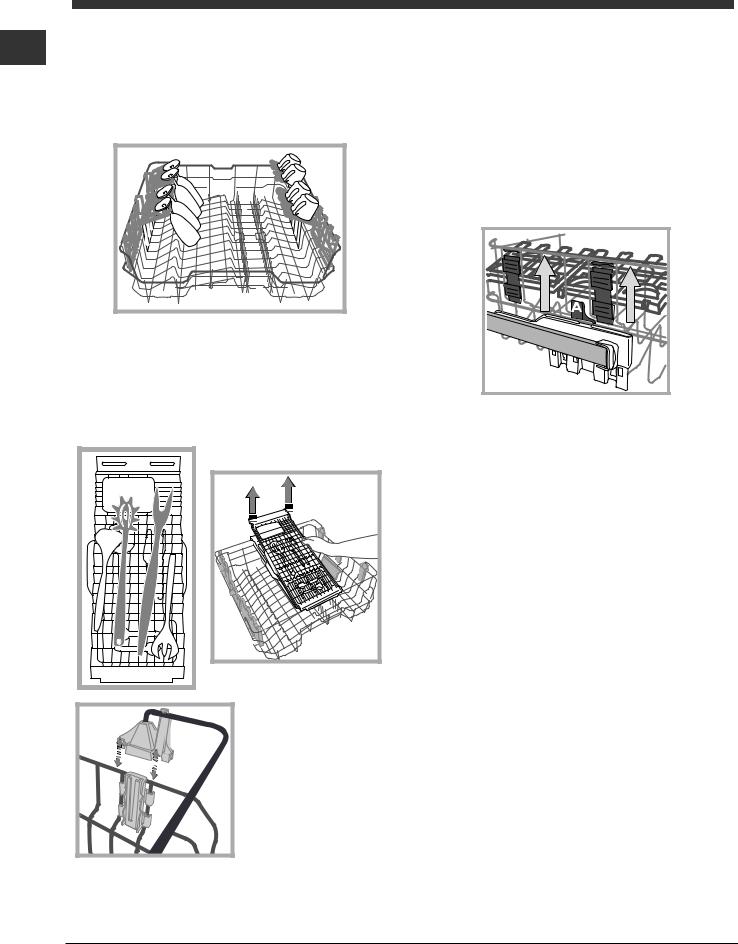
Clayettes rabattables à inclinaison variable
FR Les clayettes latérales peuvent être placées à trois hauteurs différentes afin d’optimiser la disposition de la vaisselle dans le panier.
Les verres à pied peuvent être placés en position stable sur les clayettes rabattables en insérant la tige de leurs pieds dans les fentes prévues à cet effet.
Plateau range-couverts*
Certains modèles de lave-vaisselle sont équipés d’un plateau coulissant qui peut être utilisé pour laver les couverts ou les petites tasses. Éviter de charger sous le plateau de la vaisselle encombrante pour bénéficier de meilleures performances de lavage.
Le plateau à couverts est amovible. (voir figure).
Avant de charger le plateau, assurez-vous que les supports sont solidement accrochés au panier supérieur. (voir figure).
Le panier supérieur est réglable en hauteur selon les besoins : en position haute, il permet de ranger de la vaisselle encombrante dans le panier inférieur ; en position basse, il permet d'exploiter au mieux l'espace des clayettes et des secteurs rabattables en créant plus de place de rangement vers le haut.
Régler la hauteur du panier supérieur
Pour faciliter le rangement de la vaisselle, il est possible de régler le panier supérieur en position haute ou basse.
Régler de préférence la hauteur du panier quand ce dernier est VIDE.
Ne JAMAIS soulever ou abaisser le panier d’un seul côté.
Si le panier est équipé de Lift-Up* (voir figure), soulever le panier en le saisissant par les côtés et le déplacer vers le haut. Pour revenir à la position basse, appuyer sur les leviers (A) sur les côtés du panier et l'aider à descendre vers le bas.
Vaisselle non appropriée
•Couverts et vaisselle en bois.
•Verres décorés et fragiles, vaisselle artisanale artistique ou ancienne. Leurs décors ne sont pas résistants.
•Parties en matière synthétique ne résistant pas à la température.
•Vaisselle en cuivre ou en étain.
•Vaisselle sale de cendre, cire, graisse lubrifiante ou encre.
Les décors sur verre, les pièces en aluminium ou argent risquent de changer de couleur et de blanchir en cours de lavage. Certains types de verre (les objets en cristal par exemple) deviennent opaques après de nombreux lavages.
Endommagement du verre et de la vaisselle Causes :
•Type de verre et procédé de fabrication du verre.
•Composition chimique du produit de lavage.
•Température de l'eau du programme de rinçage.
Conseils :
•N'utiliser que des verres et de la porcelaine garantis par le fabricant comme résistants au lavage en lave-vaisselle.
•Utiliser un produit de lavage délicat pour vaisselle.
•Sortir les verres et les couverts du lave-vaisselle le plus rapidement possible après la fin du programme.
* Présent uniquement sur certains modèles.
22
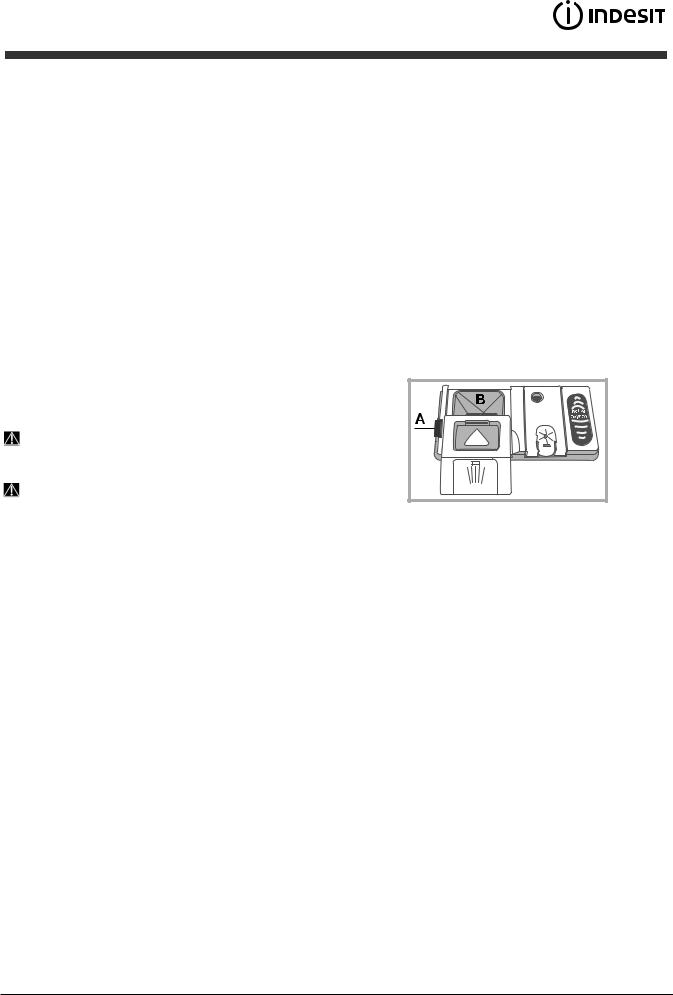
Mise en marche et utilisation
Mettre en marche le lave-vaisselle
1.Ouvrir l’arrivée d’eau.
2.Appuyer sur la touche ON-OFF pour allumer l’appareil.
3.Ouvrir la porte et doser le produit de lavage (voir « Charger le produit de lavage »).
4.Charger les paniers (voir Charger les paniers) et fermer la porte.
5.Sélectionner le programme désiré en tournant le bouton
SÉLECTION PROGRAMME : amener le repère sur le bouton en face du numéro ou du symbole du programme. Le voyant de la touche MARCHE/PAUSE s'allume.
6.Sélectionner les options de lavage* (voir Options et Programmes Spéciaux).
7.Appuyer sur la touche MARCHE pour démarrer, le voyant cesse de flasher et passe au fixe. Le voyant correspondant au lavage s’allume pour signaler le démarrage du programme.
8.A la fin du programme, la touche FIN s’allume (lumière fixe). Eteindre l’appareil par pression sur la touche ON-OFF, fermer le robinet de l’eau et débrancher la fiche de la prise de courant.
9.Attendre quelques minutes avant de sortir la vaisselle pour
éviter de se brûler. Décharger les paniers en commençant par celui du bas.
- Pour réduire sa consommation d'énergie, la machine s'éteint automatiquement dans certaines conditions de non-utilisation prolongée.
PROGRAMMES AUTO* : un capteur spécial qui équipe certains modèles de lave-vaisselle peut évaluer le degré de salissure et sélectionner le lavage le plus efficace et le plus économique. La durée des programmes
Auto peut varier du fait de l’intervention du capteur.
Modifier un programme en cours
En cas d’erreur de sélection d’un programme, il est possible de le modifier, à condition qu’il vienne tout juste de démarrer : pour changer un cycle de lavage en cours, éteindre puis rallumer l’appareil par une pression prolongée sur la touche
ON/OFF, sélectionner ensuite le nouveau programme et les options désirées.
Introduire de la vaisselle en cours de lavage
Appuyer sur la touche Marche/Pause, ouvrir la porte en faisant attention à la vapeur chaude qui s’échappe et introduire la vaisselle. Appuyer sur la touche Marche/Pause : le cycle
 redémarre après un bip prolongé.
redémarre après un bip prolongé.
En cas de sélection d’un départ différé, une fois le compte à rebours terminé, le cycle de lavage ne démarre pas, il reste en Pause.
 Toute pression sur la touche Marche/Pause pour mettre l’appareil en pause, stoppe le programme.
Toute pression sur la touche Marche/Pause pour mettre l’appareil en pause, stoppe le programme.
Pendant cette phase, aucun changement de programme n’est possible.
Interruptions accidentelles
En cas d’ouverture de la porte en cours de lavage ou de coupure de courant, le programme s’arrête. Il redémarre du point où il a été interrompu dès que le courant revient ou que la porte est refermée.
* Présent uniquement sur certains modèles.
Charger le produit de lavage |
|
|
FR |
||
Un bon résultat de lavage dépend aussi d’un bon |
||
|
||
dosage du produit de lavage. Un excès de produit de |
|
|
lavage ne lave pas mieux et pollue l’environnement. |
|
Selon le degré de salissure, le dosage peut être adapté au cas par cas en utilisant un produit de lavage en poudre ou liquide.
En cas de vaisselle normalement sale, utiliser environ 35 g (produit de lavage en poudre) ou 35ml (produit liquide). En cas d'utilisation de tablettes, une seule suffit.
En cas de vaisselle peu sale ou précédemment rincée à l'eau, réduire considérablement la quantité de produit de lavage.
Pour un bon résultat de lavage, suivre également les instructions reportées sur l'emballage.
Pour toute autre demande de renseignements, s'adresser aux services d'aide aux consommateurs des fabricants de produits de lavage.
Pour ouvrir le distributeur de produit de lavage, actionner le dispositif d'ouverture « A »
Introduire le produit de lavage dans le bac « B » bien sec. La quantité de produit de lavage consacrée au prélavage doit être placée directement dans la cuve.
1.Doser le produit de lavage en consultant le Tableau des programmes pour introduire une quantité appropriée.
Dans le bac B, un indicateur de niveau indique quelle est la quantité maximale de de lavage, liquide ou en poudre, pouvant
être utilisée pour chaque cycle.
2.Eliminer les résidus de produit de lavage sur les bords du bac et fermer le couvercle jusqu’au déclic.
3.Fermer le couvercle du distributeur de produit de lavage en le poussant vers le haut jusqu'à enclenchement du dispositif de fermeture.
Le distributeur à produits de lavage s'ouvre automatiquement selon le programme, au moment voulu.
En cas d'utilisation de produits de lavage tout en un, utiliser l'option TABLETTES qui adapte le programme de lavage de manière à toujours obtenir les meilleurs résultats de lavage et de séchage possibles.
 N’utiliser que du produit de lavage spécial lave-vaisselle.
N’utiliser que du produit de lavage spécial lave-vaisselle.
NE PAS UTILISER de produits pour laver la vaisselle à la main.
Une utilisation excessive de produit de lavage peut laisser des résidus de mousse en fin de cycle.
L’utilisation de tablettes de lavage n’est conseillée que pour les modèles qui prévoient l’option TABLETTES MULTIFONCTIONS.
Pour obtenir des performances de lavage et de séchage optimales, utiliser des produits de lavage en poudre, du liquide de rinçage et du sel.
23

Programmes
|
|
|
|
|
|
|
|
|
|
|
Les données des programmes sont mesurées dans des conditions de laboratoire selon la norme européenne EN 50242. |
||||||
FR |
|
|||||||
|
Selon les différentes conditions d’utilisation, la durée et les données des programmes peuvent être différentes. |
|||||||
|
|
|||||||
|
|
|
Le nombre ainsi que les types de programmes et d’options varient selon le modèle de lave-vaisselle. |
|||||
|
|
|
|
|
|
|
|
|
|
|
|
|
|
|
Durée du |
Consommation |
Consomation |
|
|
|
Programme |
Séchage |
Options |
d’eau (litre/ |
d’énergie (KWh/ |
|
|
|
|
programme |
|||||
|
|
|
|
|
|
cycle) |
cycle) |
|
|
|
|
|
|
|
|
||
|
|
|
|
|
|
|
|
|
|
|
1. |
Eco |
Oui |
Non |
03:10’ |
11 |
1,04 |
|
|
|
|
|
|
|
|
|
|
|
2. |
Intensif |
Oui |
Non |
02:30’ |
16,5 |
1,65 |
|
|
|
|
|
|
|
|
|
|
|
3. |
Normal |
Oui |
Non |
02:00’ |
16,0 |
1,3 |
|
|
|
|
|
|
|
|
|
|
|
4. |
Rapide |
Non |
Non |
00:40’ |
9,0 |
0,9 |
|
|
|
|
|
|
|
|
|
|
|
5. |
Prélavage |
Non |
Non |
00:10’ |
4 |
0,01 |
|
|
|
|
|
|
|
|
|
Indications sur le choix des programmes et dosage du produit de lavage
1. Le cycle de lavage ECO est le programme standard auquel se référent les données de l’étiquette-énergie. Ce cycle est prévu pour le lavage de la vaisselle normalement sale et est le programme le plus efficace en termes de consommation d’énergie et d’eau pour
ce type de vaisselle. 27 gr/ml + 6 gr/ml** – 1 tablette (**Quantité de produit du prélavage).
2.Vaisselle et casseroles très sales (déconseillé pour la vaisselle fragile) 30 gr/ml – 1 tablette.
3.Vaisselle et casseroles normalement sales. 27 gr/ml + 6 gr/ml** – 1 tablette.
4.Cycle rapide conseillé en cas de vaisselle peu sale (idéal pour 2 couverts) 25 gr/ml – 1 tablette.
5.Lavage préalable dans l’attente de compléter le chargement au repas suivant. Pas de produit de lavage.
Consommations en stand-by : Consommation en left-on mode : 5 W - Consommation en off-mode : 0,5 W.
Remarque :
pour obtenir des performances optimales avec le programme « Rapide » il est conseillé de respecter le nombre de couverts indiqué.
Pour consommer moins, utiliser le lave-vaisselle à pleine charge.
Note pour les laboratoires d’essai : pour toutes informations sur les conditions d’essai comparatif EN, s’adresser à : ASSISTENZA_ EN_LVS@indesitcompany.com
24
